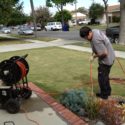Picture this…
You have a complete sewer line full of grease, sludge, grime, gunk, and debris that have built up over years of use. When a drain clog occurs and your fixtures (such as toilets, sinks, and tubs) begin to back up or hold water, the first approach is generally to use a drain snake or rooter to clear the clog.
The rooter then acts as a prod and punctures holes through this build-up in order to clear a passageway for drain water. This will solve your immediate problem and your drain lines will begin to flow again, but the question is: FOR HOW LONG? Sometimes this remedy will last a day or two, sometimes a few months, but never too long. That’s where hydro-jetting (aka hydro-scrubbing) comes into play!
WHAT IS HYDRO-JETTING?
Hydro-jetting is a process that utilizes a high-pressure water stream, shooting out of a hose at a pressure of up to 3,500 psi, in order to cut through any and all of the sludge and gunk (and even stubborn tree roots and mineral build-up) that is clogging your drain. It is typically done through a special opening called a cleanout (located on the exterior of most homes), which allows your plumber easier access to clean out your drain lines. (If you do not have a cleanout, it is definitely recommended that you get one installed first.)
SO WHAT’S THE DIFFERENCE BETWEEN SNAKING & HYDRO-JETTING?
Well, it’s often easier to describe by way of a picture, so below is a simple diagram example of the differences between snaking a drain and hydro scrubbing a drain.
SO WHEN IS HYDRO-JETTING RECOMMENDED?
Hyrdo-jetting is generally recommended as a solution when clogs cannot be removed through the traditional snaking or rooter methods, generally due to high grease/sludge content or root intrusion in your drain pipes. A plumber can let you know the amount of resistance or how stubborn a clog is to remove and from there, they will generally recommend hydro-jetting if they think it is necessary.
So, if your plumber recommends hydro-jetting, your best bet (for lots of time and money savings due to repeat clogging) is to go for it! Hydro-jetting (so long as there is not any serious root intrusion which is explained below), will help bring your sewer pipes back to a “like-new” condition and save you from the headaches and pocketbook aches of having to call a plumber for repeat clogs! So what are you waiting for? Don’t be silly, get your drain lines hydro-scrubbed today!
A BIG SIDE NOTE ABOUT ROOT INTRUSION AND HYDRO-JETTING
One thing to keep in mind, although hydro-jetting is great at clearing stubborn roots from inside your drain lines, root intrusion that is invasive enough to cause repeat backups is a clear sign for much more serious concern. Repeat stoppages caused by root penetration in your drain lines generally mean that the roots have gotten thicker and have altered your pipelining, which is a fair warning for larger pipe damage in the near future.
With this, a plumber will generally recommend a sewer camera inspection in order to locate and determine the severity of the issue. In serious cases, a plumber may recommend either partial or complete sewer pipe replacement, in order to avoid pipe breakages or pipe bursts that can cause a much larger mess and cost much more to clean up.



